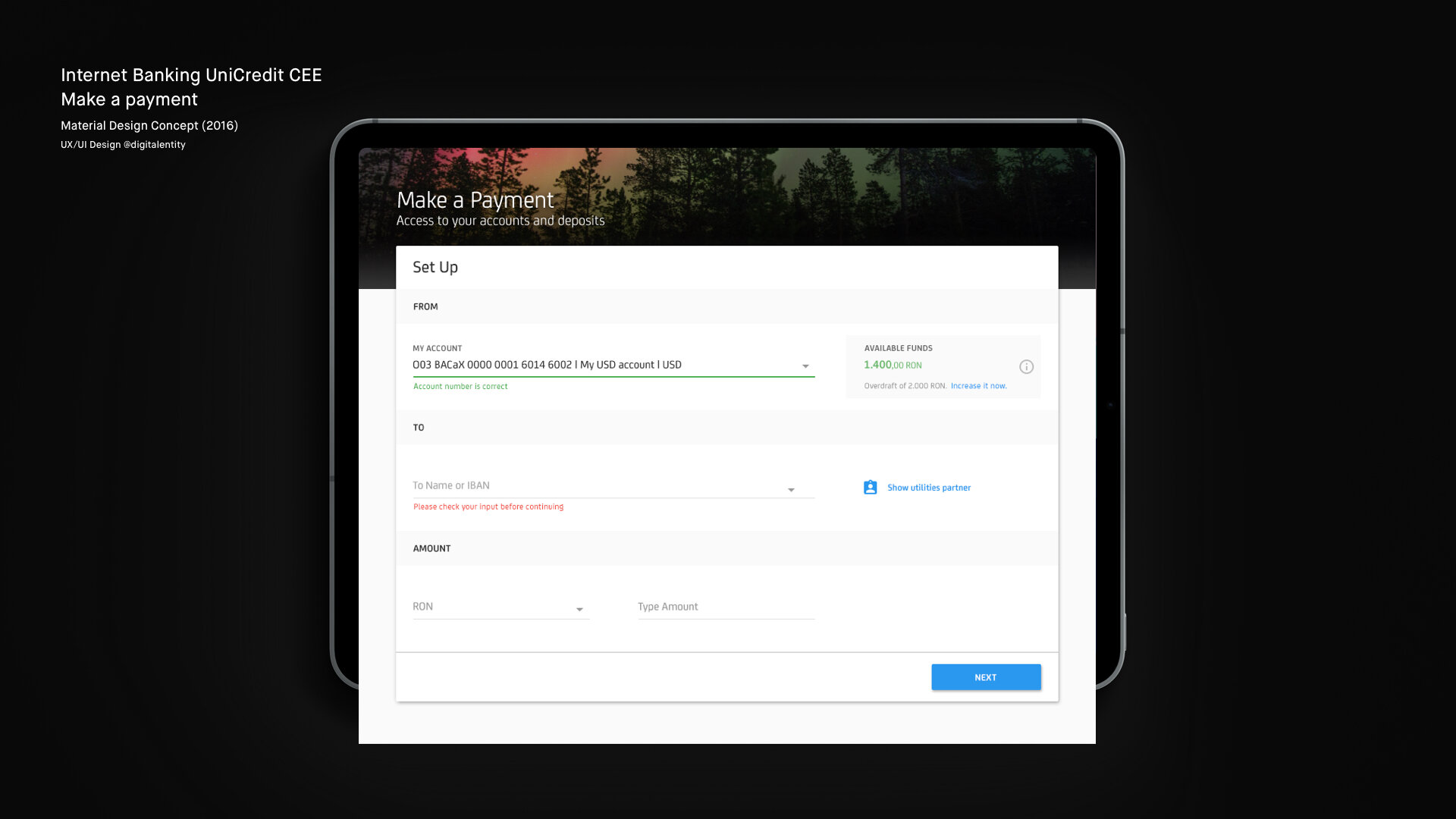
Seven countries, one bank: the new mobile banking app
UniCredit Bank Central & Eastern Europe (CEE) Retail Division in Vienna, decided to innovate their existing mobile banking 1.0 creating, what they called, mobile banking 2.0.
The biggest change involved the integration of Meniga, leading European FinTech’s digital banking software, to make customers' experience more personalized with focus on data-driven tailored content. They wanted to give a fresh & modern look while also completely changing their backend system.
CLIENT
UniCredit
2015-2019
MY ROLE
Sr UX/UI Designer
@Digital Entity
TEAM
Sr UX Designer - Christian Siega
Sr UX Designer - Laura Potenti
UI Designer - Alma Rotaru
UX Designer - Alessandro Previati
Head of Design - Nik Horn
Senior UX/UI Designer
Together with Christian Siega - Sr UX Designer, Laura Potenti - Senior UX designer, Alma Rotaru - UI designer, and Alessandro Previati - UX Designer, we shaped the entire mobile banking app experience putting the user and her/his financial wealth at the centre.
We re-imaged the app, adapted it to 7 different Eastern European countries, markets, languages and users' behaviours making, sure to have one app that was shaped according to its context and people.
It was a fast-paced environment that involved many stakeholders, various countries and several languages. For example, we started off the project with Serbia, so we had to interact with stakeholders from their bank in Belgrade, review the existing flows with the BAs in Bucarest and the POs in Vienna, while being directed by the PM in Bucarest and working side by side with developers in Zagreb.
We designed 7 apps, in 7 different countries, and 7 languages all in 18 months
We started with a pilot and rolled out other 6 apps.
We created the perfect work process, and it worked.
The work process, when the team is big and in remote
Have daily calls - with the stakeholder of the local bank, POs, BAs, PMs, frontend developer (iOS and Android), backend developers, tech leads and designers all working in 4 different countries: Austria, Romania, Croatia and Serbia.
Work together with the BAs - The PM divided the project into pillars, according to the effort of each pillar we would have one or two weeks to work on that functionality. Together with Chris, Laura and Alessandro, we unraveled the existing functionality with the BA sharing details and screens on Confluence.
Part of the beautiful team, when we all met in Vienna
My BA friend Adrian from Romania
Know your customer: together with the stakeholder of the bank in Belgrade, we analyzed their customers, did interviews, created personas and journeys, checked the analytics of the current app etc.
Create wireframes and validate with the agile team - Laura, Ale and I created the flows (with all possible scenarios) directly in UI using the design system components that I created and maintained, and we shared them with the entire team at the end of the day, every day. The morning after we checked the flows all together, collected the feedback, made the changes...and so on till the final delivery.
Proto-personas created from real data
Hero user journey for concept creation
Wireframe flow
Move to the next pillar - Once we finished with one pillar we'd move to the next one, if we missed something, we would add it to the backlog weeks that were planned after the last pillar.
Validate - we had one meeting per month together with the Head of CEE retail where we showed the progress of the functionalities we covered and the design outcomes.
Enhance communication and work process - While working on the pilot app we learned and refined different aspects: how to work together, how to communicate and collaborate with the team, how to share assets & flows, how to leave comments in a structured way.
Get ready for the next country - Before closing the pilot app for Serbia we worked ahead for the next country, Czech Republic. We mapped their features with the ones existing in Serbia, and categorized the features as following: new ones, existing ones that needed adjustment, and existing ones that could be replicated as is. We did this thorough analysis for all the other five countries too.
Discover bugs, CRs and add them on Jira - After the development of the last features we started the testing phase with a two days hackathon, in which we created design bugs and design change requests.
Feature mapping between Serbia, Czech Republic and Bosnia
Design System library- I started reading a lot about it, documenting myself, watching a lot of videos of people that explained how to do it and why companies should do it. I run the idea with Nik, who loved it and gave me the OK to proceed. I worked closely with the other designers and the developers in order to create something that was easy to consume by everybody in the team. It took some time, but once we all started using it, I realized how proud I was of this huge achievement. I was the guardian of it, I kept it well maintained, and I adjusted it according to the project's needs.
Me in Milan at Digital Entity offices, showing DS methodology
User testing and changes - The team run a neuroscience user testing phase twice during the project, the first time with the use of a prototype before the app release, the second time instead with the real app after its release. The major discoveries done during the testing phase were documented and taken into consideration while designing for the other six countries, and for the new releases of the Serbian app.
Some picture of the neuroscience user testing phase


































